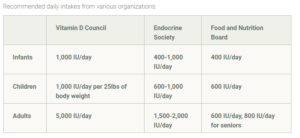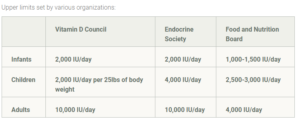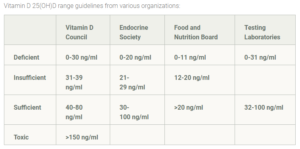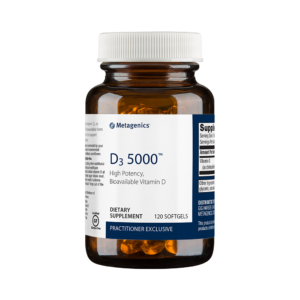The answer is probably YES. In fact, most Minnesotans need to supplement.
The basics….
- Vitamin D is fat soluble which means it can be stored
- Vitamin do is produced endogenously, so it is technically a vitamin, some consider it to be a hormone
- Vitamin D acts as a co-factor for various cell functions
- We get Vitamin D naturally from the sun (UVB rays)
- Those living certain areas may need more vitamin D
- Vitamin D has to go through two hydroxylations to be activated in the body, one in the liver and one in the kidney
- Vitamin D2 comes from fortified foods and supplements, Vitamin D3 comes from the sun, fish and other foods, and supplements. Vitamin D3 is optimal.
- It is difficult to get adequate vitamin D through diet
- All ages will benefit from vitamin D
- There is still a lot we don’t know about vitamin D
What does it do?
- Vitamin D promotes calcium absorption for normal musculoskeletal function
- We’ve known for a long time that Vitamin D helps build strong bones but it may do more…
- Vitamin D may also have neurological, immune, and cell growth functions
- We are still learning more about vitamin D and what roles it may play
- What we do know is that MANY cells have vitamin D receptors which are a good indicator that it may have many different and unknown functions.
What are symptoms of low vitamin D?
Symptoms are vague and differ from person to person. Some symptoms include:
- Fatigue
- Bone pain
- Muscle aches
- Frequent illness
- Depression
- Back pain
- Hair loss
Who is at risk for vitamin D deficiency?
- Pregnant women (as many as 80% of pregnant women are deficient)
- Obese individuals
- Darker skinned individuals
- Breastfed infants
- Individuals that live in northern climates
- Night shift workers
- Those who stay indoors
- Those who take certain medications such as steroids, anti-seizure medications, cholesterol medications, and more)
- Individuals who have had gastric bypass surgery
- Those that have low magnesium
- Those with chronic bowel, kidney, or liver disease
Vitamin D for certain populations
- Pregnancy and lactation
- Many pregnant women are deficient in Vitamin D and may need up to 5000 IU/day. This may improve the health of mom and baby.
- Breastfed infants do not typically get enough Vitamin D through breastmilk. Vitamin D does cross the barrier however, infants need about 400 IU/day. For infants to get this mom’s concentration must be adequate (~36 nm/mol). Mom will most likely have to take ~6400 IU/day to maintain enough for bother her and baby. If mom is taking less than 6000 IU/day she will most likely need to supplement her baby
- In formula there is approximately 20 IU of vitamin D
- Darker skinned individuals
- Takes longer to get vitamin D from the sun.
- Those that live in northern climates
- Minnesotans don’t store enough for the winter months and we don’t get any from the sun during the winter.
- “Allina studied its employeesin the winter of 2010 and found 60 percent had low vitamin D levels, 30 percent were very low and 6 percent were profoundly low.” (Brown, 2017)
Sources of Vitamin D
Let’s talk dietary sources first….
- Cod Liver oil (~170 IU in 1 tsp)
- Swordfish (~566 IU)
- Salmon (~447 US)
- Most other sources have been fortified or offers less than <100 IU
The Sun…
As previously mentioned we get Vitamin D from UVB rays.
- Between 10am-3pm is the optimal time to go outside for vitamin D
- We get a good dose within 10-15 mins if lighter skinned, if darker skinned it may be six times that amount or up to two hours
- We DO NOT need to burn in order to get vitamin D
- Sunscreen DOES impact the amount of vitamin D we get, in fact it is estimated that SPF 30 or more reduced vitamin D production in the body by 95-98%
- We get about 10,000-25,000 IU from the sun. WOW! Amazing fact: the body knows when it has gotten enough vitamin D from the sun and won’t continue to make it after adequate levels have been reached. This is yet another example of how intelligent our bodies are!
- In MN most likely Oct-April we can’t make any
- Tanning beds may or may not be helpful, they also have additional risk of skin damage
- Light boxes may be an option (I am not an expert on these!)
- Good intensity would be 10,000 lux
- Duration should be about 20-30 minutes/day
- Timing early morning is best, sticking to a routine is best.
This is why it is important for Minnesotans to get levels checked and potentially supplement. It is VERY difficult to get adequate amounts through diet and from Oct-April we don’t get enough. MOST MINNESOTANS NEED TO SUPPLEMENT.
A few other factors to consider…
- Vitamin D increases calcium in the body. This has been considered to be the main function of vitamin D for years. Since Vitamin D increases calcium there have been concerns with hypercalcemia (too much calcium). John Cannel, MD notes that if taking proper amounts of vitamin D we may not need to take as much calcium. It is important to talk to your doctor about your calcium needs, especially if taking vitamin D. If you are supplementing with vitamin D and calcium, eating a well-rounded diet, use calcium fortified products, you may be getting too much Calcium is tightly-regulated in the body so it is important to monitor levels.
- Parathyroid hormone (PTH) also regulates serum calcium. If we get too little vitamin D we will have high PTH and poorer bone health, conversely if we get too much vitamin D we will have less of a need for PTH or may be more prone to hypercalcemia.
- Magnesium is required for the absorption of Vitamin D, so if levels of magnesium are low (most are deficient) you may not be getting optimal vitamin D even if supplementing
- Vitamin K2 also helps with Vitamin D, specifically MK7
- Vitamin K2 will help reduce chances of becoming hypercalcemic. K2 works synergistically. Vitamin K2 helps calcium get to target tissues.
- Vitamin K1 from leafy greens, Vitamin K2 from organ meats.
Vitamin D2 versus D3
- Vitamin D2 is NOT the human form of vitamin D, it is made from plant material
- Vitamin D2 can be synthetically made
- Vitamin D3 is what the body produces
- Vitamin D2 may actually decrease the optimal D3 in the body
- Vitamin D2 is usually what MDs prescribe
How much do I need?
It is almost impossible to definitively say what dose you need without testing.
- It depends on who you ask… different sources have different recommendations
- This isn’t necessarily a bad thing. These resources are usually talking to a specific patient audience.
- Previously, some MDs were taught that a dose of 1,000 IU/day was toxic; we have found this to be not true.
- Since needs vary so much it is best to have your levels testing to know exactly what does you need.
- For most Minnesotans I personally think most can handle a daily dose of 5,000 IU/day. Some may need more, some may need less. And of course as discussed, depending on time of year dosages may need to be adjusted.
From the Council on Vitamin D:

For upper limit intakes:

What should my levels be and how do I get them checked?
An ideal level is something else that is also debated. The range for “normal” vitamin D is large and confusing; I suspect this to change as more research comes out. To sustain adequate levels most need supplement.
From the Council on Vitamin D:

The Council on Vitamin D, and myself, thinks it is appropriate to aim for a range of 50 ng/ml. It has been suggested to maintain a level of 40 ng/ml we need to take 5,000 IU or higher (daily).
It has also been noted that outdoor workers naturally have levels of 60-80 ng/ml which means we should be able to function just fine at those higher levels.
How do you get your levels checked?
- Ask your doctor to test your levels
- Get a referral for your doctors to test levels
- Have labs ordered at our office!
Does it matter what type of supplement I take?
- I never recommend patients start taking a supplement without the guidance of a health care provider. While Vitamin D is important there may interactions with vitamin D. So consult with a health care provider first!
- Quality DOES matter when it comes to supplements. Always make sure you are taking vitamin D3 not D2.
- Quality always matters with supplements
- Most multivitamins don’t contain enough, multivitamins have about a measly 20 IU of vitamin D
- Also you may consider taking Magnesium or K2 along with Vitamin D3. Finally, you may want to check your calcium levels to see if you need to make any adjustments there.
- It doesn’t seem that capsules versus drops matter, they both seem to do a good job!
- Drops are great for kids.
- It is possible to take too much vitamin D so consult with a health care provider.
I typically recommend Metagenics because I know they have high quality products. Vitamin D3 is our supplement of the month and for the rest of December is 10% off.

Learn more about Dr. Brittany Schmidt here
Not intended as medical advice, for education purposes only.
Resources:
Associations between vitamin D levels and depressive symptoms in healthy young adult women.
D Kerr-D Zava-W Piper-S Saturn-B Frei-A Gombart – https://www.ncbi.nlm.nih.gov/pubmed/25791903\
How do I get the vitamin D my body needs?
Inverse Relationship between Metabolic Syndrome and 25-Hydroxyvitamin D Concentration in Elderly People without Vitamin D deficiency.
C Wang-C Chang-Y Chang-S Wu-C Chiu-M Hou-C Chen-P Liu-C Wu – https://www.ncbi.nlm.nih.gov/pubmed/30451913
Low vitamin D levels are associated with cognitive impairment in patients with Hashimoto thyroiditis.
J Xu-X Zhu-H Sun-X Xu-S Xu-Y Suo-L Cao-Q Zhou-H Yu-W Cao – https://www.ncbi.nlm.nih.gov/pubmed/30477467
Parathyroid glands and vitamin D
https://www.vitamindcouncil.org/parathyroid-glands-and-vitamin-d/#.XBAXJlVKjIU
Role of Magnesium in Vitamin D Activation and Function
Anne Uwitonze-Mohammed Razzaque – http://jaoa.org/article.aspx?articleid=2673882
The Levels of Vitamin D, Vitamin D Receptor, Homocysteine and Complex B Vitamin in Children with Autism Spectrum Disorders.
H Altun-E Kurutaş-N Şahin-O Güngör-E Fındıklı – https://www.ncbi.nlm.nih.gov/pubmed/30466210
Vitamin D Deficiency
https://medlineplus.gov/vitaminddeficiency.html
Vitamin D deficiency is associated with dyslipidemia: a cross-sectional study in 3,788 subjects.
X Jiang-M Peng-S Chen-S Wu-W Zhang – https://www.ncbi.nlm.nih.gov/pubmed/30479168
Vitamin D during pregnancy and breastfeeding
https://www.vitamindcouncil.org/vitamin-d-during-pregnancy-and-breastfeeding/#.XBAojFVKjIV
Vitamin D Deficiency Is Associated With an Increased Likelihood of Incident Depression in Community-Dwelling Older Adults.
R Briggs-K McCarroll-A O’Halloran-M Healy-R Kenny-E Laird – https://www.ncbi.nlm.nih.gov/pubmed/30470577
Vitamin D deficiency and psychotic features in mentally ill adolescents: a cross-sectional study.
B Gracious-T Finucane-M Friedman-Campbell-S Messing-M Parkhurst – https://www.ncbi.nlm.nih.gov/pubmed/22571731
Vitamin D Test Kit | DIY At-Home Vitamin D Testing
https://www.vitamindcouncil.org/about-vitamin-d/testing-for-vitamin-d/#.XBAeflVKjIU
Reference for Allina study, article by Heather Brown: https://minnesota.cbslocal.com/2017/12/19/gq-winter-sun/
*For educational purposes only, not intended as medical advice*
